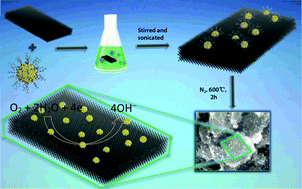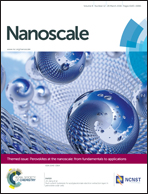Oxygen reduction catalyzed by gold nanoclusters supported on carbon nanosheets†
Abstract
Nanocomposites based on p-mercaptobenzoic acid-functionalized gold nanoclusters, Au102(p-MBA)44, and porous carbon nanosheets have been fabricated and employed as highly efficient electrocatalysts for oxygen reduction reaction (ORR). Au102(p-MBA)44 clusters were synthesized via a wet chemical approach, and loaded onto carbon nanosheets. Pyrolysis at elevated temperatures led to effective removal of the thiolate ligands and the formation of uniform nanoparticles supported on the carbon scaffolds. The nanocomposite structures were characterized by using a wide range of experimental techniques such as transmission electron microscopy, scanning electron microscopy, X-ray photoelectron spectroscopy, X-ray diffraction, UV-visible absorption spectroscopy, thermogravimetric analysis and BET nitrogen adsorption/desorption. Electrochemical studies showed that the composites demonstrated apparent ORR activity in alkaline media, and the sample with a 30% Au mass loading was identified as the best catalyst among the series, with a performance comparable to that of commercial Pt/C, but superior to those of Au102 nanoclusters and carbon nanosheets alone, within the context of onset potential, kinetic current density, and durability. The results suggest an effective approach to the preparation of high-performance ORR catalysts based on gold nanoclusters supported on carbon nanosheets.


 Please wait while we load your content...
Please wait while we load your content...